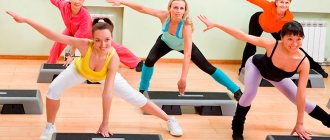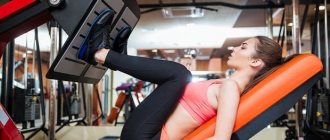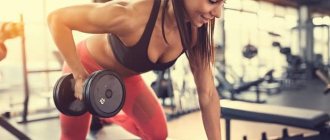Description of body ballet
It would be stupid to deny the popularity of classical choreography. While the types of fitness in the ratings of trainers change each other, ballet always remains in trend. Even now, little girls admire the beauty of ballerinas, who are deservedly considered examples of beauty and grace. And if not everyone is destined to get into classical ballet, body ballet is designed for a wider range of people.
The direction became popular only in the late nineties of the last century. Its main goal is to make fitness not only active, but also graceful and sophisticated. Plus, this is an excellent opportunity for those who have long wanted to join classical choreography.
It is important not to confuse body ballet with ballet itself. These are completely different directions, the first is fitness, and the second is full-fledged choreography, a form of art. Body ballet does use some of the movements of their classical choreography, but the program also includes exercises and techniques from yoga, Pilates, stretching and other types of fitness in equal quantities. The program is adapted for all fitness fans who want to tone their body. And in addition to losing weight and pumping up muscles, body ballet gives you grace, beautiful posture and body flexibility.
The basis of body ballet is popular movements from the arsenal of ballerinas. All ballet steps and plies will be adapted in such a way as to place emphasis not so much on technique, but on the very essence of the exercise. Even if you've never danced before or even gone to the gym, body ballet is right for you. All complex ballet movements are adapted in such a way that even a beginner can easily learn popular positions and get closer to the beauty - classical choreography.
What is body ballet?
The founder of the direction is considered to be choreographer and fitness expert Leah Sarago. In 2005, she released a video course, Ballet Body (now available in the AppStore), in which she mixed exercises from ballet, yoga and Pilates - it promises to make your figure toned and slender without intensive training (and is still popular).
In Russia, the idea of combining Pilates and ballet is supported by Ilze Liepa. In general, the idea of mixing ballet with other areas is quite popular (our Olya went to yoga ballet last year).
The main part of the lesson is exercises from classical choreography. This is the foundation that gives you the strength and flexibility to dance complex steps. But here we take into account the age and training of the students. Plus, exercises are given for general physical fitness and butt + abs (we have already done this lesson together with Pro Trainer).
Training
What does a typical body ballet training consist of? The program depends on the preferences of the trainer himself and the specific level of training of the group. But in general, the following algorithm is used:
- A little body workout. You need to warm up your muscles and joints to avoid possible injuries. If you are going to exercise at home, it is very important not to neglect the warm-up - this way you reduce the risk of injury.
- A set of exercises at the machine. At this moment you can feel like a real ballerina! The same machine, and the same mirror for honing the correctness and grace of movements - the atmosphere itself is worth attending such training at least once.
- Free exercises outside the machine. These are adapted pas or plies. As a rule, they are performed at a slightly more active pace than in classical ballet. This helps you shed extra pounds and makes your workout more aerobically rewarding.
- A set of Pilates exercises. This part of the workout is designed to strengthen the core and abdominal muscles, and back muscles. Thanks to Pilates, it will be easier for you to maintain your posture, you become more flexible, and your muscles acquire the desired tone.
- Stretching. At the end of the workout, stretching is performed to consolidate the results. After previous exercises, the muscles are already sufficiently warmed up. A few body ballet classes with conscientious stretching - and you will be able to do the desired splits.
The complex that is included in the body ballet training will help you improve your overall physical fitness and help you achieve the desired shape. Training can be used as additional stress when losing weight. But other types of fitness will give you all this. But body ballet will give your movements such exquisite grace, plasticity and femininity. You will learn to hold your arms, legs, and back correctly. Flexibility of all parts of the body is an additional bonus from such training.
The effectiveness of body ballet for weight loss
The results of regular classes in the body ballet program have shown their effectiveness for weight loss. This is a fairly long workout, during which the heart rate is maintained high. These factors contribute to active energy expenditure and fat burning. The main load during a fitness lesson is distributed to the muscles of the back, hips and buttocks, forming their slender outline. And due to the lack of intense strength training in the fitness complex, muscle size will not grow, which means weight will not increase. Therefore, body ballet classes are popular today for weight loss among women.
So why should you do body ballet?
There are several benefits to this type of training that make body ballet a very attractive fitness option for most of us.
- During training, much attention is paid to the leg muscles. At the same time, since within the complex you combine stretching exercises and ballet positions, your legs become toned and graceful, you will not be able to pump up your calves or quadriceps, as in strength training. Body ballet will perfectly help you get rid of hated riding breeches or so-called ears. The shape of the legs becomes “chiseled”.
- Thanks to the fact that the set of exercises includes Pilates, you strengthen the muscles of the core, abs and arms. During training, you always keep your upper body in the correct position, so that the muscle frame is also strengthened by static load.
- A distinctive feature of body ballet is the constantly tense toe during exercises at the gymnastic barre and free ballet pliés. In this case, the muscle fibers are stretched lengthwise, eliminating the effect of too swung legs.
- Body ballet, thanks to elements of classical choreography, helps to develop beautiful and correct posture and a neat lift of the foot. Also, some note the excellent results of body ballet training in the fight against flat feet.
- Grace and regularity of movements are something that everyone can acquire after body ballet classes. All movements will be very flexible and attractive.
- Development of general physical fitness of the body. Body ballet can be called an ideal option for beginners or training for additional exercise. You will develop muscles, their strength and endurance.
- In body ballet training, you increase the flexibility of the body. We are talking not only about muscles, but also about tendons and joints. By the way, doctors recommend practicing body ballet and classical choreography as a preventive measure for diseases of the genitourinary system.
- Through barre training and ballet exercises, you will develop a sense of balance and coordination.
- No risk of injury. Body ballet has a very low injury rate. Classes are held at a moderate pace, with a minimum amount of jerky movements. You are working with your own weight, so the risk of muscle tearing and straining is minimal.
- During training, blood circulation is activated, so sometimes body ballet relieves long-term pain in the back, knees and “stagnation” in the muscles.
Useful information about body ballet
Body ballet and ballet are two very different things. Body ballet is based on a lighter version of exercises from ballet and classical choreography, which are complemented by techniques from Pilates and yoga. This is an adapted fitness option that is suitable for most exercisers. A “ballet figure” is rarely given by nature; it requires hard and careful work. It is classical choreography that improves posture and makes shapes more feminine and soft.
Body ballet training is based on various movements from classical choreography, such as pas, demi-plié, grand plié, relevé, batmans. However, do not be alarmed, the exercises are maximally adapted, so they will not cause difficulties even for people far from ballet. The proposed system of movements contributes to the development of the ability to control one’s own body, while the body itself becomes beautiful, graceful and flexible.
Of course, each body ballet coach builds classes at his own discretion. But, as a rule, a standard training includes the following segments:
- Warm-up, joint gymnastics
- Exercises at the gymnastic barre
- Exercises in a standing position without support
- Pilates floor exercises
- Stretching, stretching
This set of exercises will tighten the muscles of your body, improve physical fitness, and make your figure slim and toned. But body ballet is useful not only for weight loss. Correct positioning of the legs, eversion of the hips, graceful posture, beautiful position of the hands, development of plastic skills, flexibility of the spine - you will get all this as a result of regular ballet training.
10 benefits of body ballet
What are the advantages of body ballet and why has this trend in fitness gained widespread recognition?
- Ballet-based exercises work the leg muscles, making them slender and graceful. They are especially effective when working on breeches and ears on the hips. Even imperfect legs acquire a chiseled silhouette as a result of ballet exercises.
- Ballet exercises are no less useful for strengthening the core and arms. During classes, you actively engage your arms and corset muscles, thereby tightening your stomach and improving the shape of your arms and shoulders.
- During body ballet classes, you will pull on the toe, thereby causing the muscles to lengthen lengthwise rather than crosswise. Your leg muscles won't increase in width, so you don't have to worry about bulging hips like athletes do.
- Body ballet exercises improve posture, straighten the spine, and also develop the instep of the foot and get rid of flat feet.
- You will learn to control your own body, make it beautiful and mobile, and also work on the gracefulness and plasticity of movements.
- Such ballet programs develop general physical fitness. If you think that bodyweight exercises are not worth your attention, then you are mistaken. Performing various plies and batmans will make the muscles burn even in experienced practitioners.
- Body ballet will help you improve stretching and develop elasticity of muscles, joints and ligaments. You will also work on opening up the hip joints, which is especially useful for preventing diseases of the genitourinary system.
- Systematic body ballet classes develop coordination and a sense of balance.
- Low-impact ballet exercise does not have a negative or traumatic effect on muscles, ligaments and joints.
- Body ballet stimulates the functioning of internal organs, activates blood circulation, develops and strengthens joints, and rejuvenates the body.
Who is the training for, and who should try something different?
Let’s say right away that body ballet has no age restrictions - and this is another advantage of such a program. It is better to come to the training for beginners who have not yet attended more complex fitness training. This is a great way to start a healthy, stress-free lifestyle. Everything will work out for you, and you will want to come to body ballet again and again.
There are also almost no contraindications for training. However, standard medical prohibitions on physical activity also apply here. If you have problems with your heart or blood vessels, or you suffer from a serious form of varicose veins, it is better to postpone exercise until you recover. It is not recommended to visit the training room during an exacerbation of chronic diseases or during fever.
Body ballet will definitely appeal to those who:
- Wants to lose a few extra pounds and get a more refined figure.
- Strives to make the body more flexible, do the splits, or achieve some other result in stretching.
- Dreams of beautiful posture.
- Wants to achieve plasticity and gracefulness of movements.
- Looking for initial training for fitness classes.
- Avoids high-intensity exercise due to medical contraindications or personal beliefs.
Body ballet uniform
For classes, you do not need to buy a ballet tutu and a gymnastic leotard with pointe shoes. Still, this is a fitness direction, which means it requires clothing, first of all, to be comfortable and safe.
Therefore, the form for body ballet should be elastic, breathable, and comfortable. Any fitness clothing is suitable - leggings, overalls, T-shirts, tank tops.
Special shoes are not necessary; socks, slippers, sports ballet shoes or jazz shoes are suitable. It is also not prohibited to practice barefoot. Therefore, choose a convenient and suitable option for you.
The only thing is that wide pants and outerwear, as well as rough fitness sneakers, are not suitable for training. Such things hide the joints and make it impossible to see the technique of movements. And rough shoes do not allow you to pull on your toes.
Is technique important?
Despite the fact that all ballet exercises in the complex are adapted, you must monitor the technique of performing the exercises in order to achieve results and eliminate the risk of injury. At first, take a closer look at yourself in the mirror. It's better to skip one approach, but do the exercise correctly, without haste. You may need to further hone your technique at home in front of the mirror. Then the technique will become a habit, and you will be able to increase the pace of the exercises.
Make sure to keep your entire body toned during your workout. Keep your back straight and your chest out in front. Do not bend your neck - your head should look up and straight with your shoulders slightly lowered. The buttocks and stomach should be tense. This will strengthen your core muscles. Over time, it will be much easier for you to maintain the same body position not only during training, but also in everyday life.
When practicing near the machine, it is very important to only lightly touch it with your hand. Do not try to “lie down” on the machine. It should only serve as a support for balance. If you follow this technique, you will get beautiful posture and keep all the muscles of your body toned.
Often you will use more than just your body weight in your workouts. The trainer will add sports equipment to diversify your workouts and increase their intensity. In addition to exercises, fitballs (large rubber balls), small dumbbells, elastic bands, etc. can be used.
Benefits of body ballet
The growing popularity of body ballet is completely justified. After all, this direction gives exactly the results that most girls and women of any age strive for: a fit, feminine figure, beauty of movements and posture. At the same time, body ballet will never lead to pumping of muscles and the formation of an athletic figure with prominent muscles. This is an advantage for some and a disadvantage for others. Here everyone chooses for themselves. Body ballet is, first of all, femininity.
In general, the advantages of body ballet include:
- thorough study of the muscles, including such “problem” areas as riding breeches, inner thighs, buttocks, and abdomen, thanks to which they acquire a chiseled shape and elegance, and get rid of clamps;
- improvement of posture and gentle correction of the position of the spine by stretching it and strengthening the back muscles, which becomes an effective prevention of age-related diseases such as osteochondrosis, intervertebral protrusions and hernias, and also helps eliminate aching pain in the back and lower back in particular;
- developing the feet and developing the habit of pulling on the toes, which acts as a preventive measure and a means of combating flat feet;
- development of plasticity and gracefulness of movements, which will be visible even in everyday life and will definitely not go unnoticed by others;
- improvement of general physical fitness;
- developing flexibility by stretching and increasing the elasticity of muscles, which will not only surprise loved ones with new “techniques”, but will also reduce the risk of injury from accidental falls or twisting of the foot when walking in heels;
- development of coordination of movements and sense of balance;
- no shock load on muscles, joints and ligaments, which reduces the likelihood of injury during classes, even for beginners, to a minimum;
- improving the functioning of the cardiovascular and respiratory systems;
- systematic weight loss and body tightening, acquiring graceful figure contours.
At the same time, one of the main advantages of body ballet is constant self-development and strengthening of self-confidence. After all, after just a few months of training, you will notice how much more flexible and graceful your movements have become, how you automatically straighten your shoulders, even standing in transport, no longer bend over your desk, and those around you are increasingly paying attention to you, and not only men, but and women.
And given the fact that mastering new movements that please and give aesthetic pleasure brings joy, training helps relieve stress. Moreover, each lesson brings something new. Therefore, when choosing body ballet, there is no feeling of monotony and boredom. Therefore, even after several months of training, the feeling of novelty and desire to attend classes does not disappear, but rather intensifies.
Cloth
It is important to provide yourself with comfortable clothes. It’s clear that you don’t need to come to such training in what you are used to seeing ballerinas in. It is better to give preference to fabrics that are pleasant to the body, knitwear or special sportswear. These can be either leggings or comfortable sweatpants.
On the other hand, if you train in tight-fitting clothing, you will be able to monitor your exercise technique and the trainer will see if you are performing certain movements incorrectly.
Shoes should be comfortable. It is better to choose special dance shoes (they are more convenient to practice on the machine). But you can also wear Czech shoes or sports ballet shoes.
Clothes for body ballet
Clothing and equipment for body ballet are the same as for fitness. The main thing is to be comfortable.
No special clothing is required for body ballet. Suitable for classes:
- T-shirts, narrow T-shirts;
- leggings, tight pants, leggings, tights;
- Czech shoes, sneakers, special sports slippers.
Pointe shoes and a tutu are out of the question. These elements are completely optional. Clothing should be tight enough to make it comfortable for the person to exercise. Shoes should be flexible. During body ballet classes, you have to bend and stretch your feet; rough shoes will not work. You can also exercise barefoot.
Will body ballet help you lose weight?
If you have more than 5 extra pounds, then body ballet training alone is unlikely to help. On the other hand, if you are slightly overweight, then body ballet will help tone your body. After regular exercise, you will get rid of a small layer of fat, your muscles will be better defined (neat), and you will get rid of flabbiness.
By the way, body ballet is very effective when combined with strength training. If during the latter you build muscle mass and spend more energy, then during body ballet you stretch the muscle fibers. And stretching is a necessary condition for muscle recovery and growth. Additionally, with body ballet you will not lose the grace of strength training.
But if a body ballet trainer gives you training at a higher intensity, then you can burn extra calories and lose weight. Also, if you lead a predominantly sedentary lifestyle, then even a little activity will have a positive effect on the weight loss process.
Body ballet exercises
When you perform body ballet exercises, you need to stay for 5-10 seconds in each position. Such classes will help you acquire beautiful, and most importantly, correct posture.
Body ballet exercise No. 1
So, pull your stomach in, your back should be straight. Raise your arms up, straighten up and stretch as much as possible. The shoulders should remain down in this position. Breathing is natural, smooth and without delay.
Bring one leg back, placing it firmly on your toes. In this position, you need to raise your arms up, and turn your palms so that they look at each other. When performing this exercise correctly, our body should resemble a curved straight line.
After which, remaining in the same position of the legs, smoothly lower the arms to the first position. The bend of the body does not change.
Exercise No. 2
The legs are connected: the toe of one leg touches the heel of the other. Rise smoothly onto your toes and stretch your entire body upward. In this case, one hand should be raised and continue the straight line of our body. Then you should change the position of your legs and arms and repeat the body-ballet exercises in exactly the same way, but as if in a mirror image.
Now step forward a little while bending your knees. The body is smoothly directed forward along with one of the arms. Having done this exercise, repeat it, but again changing the position of your arms and legs.
Please note: the stomach should be pulled in, the posture should be straight, the shoulders should be in a natural position. The core stretch for all ballet exercises should be combined with the positions of the entire body, including the position of the arms and legs.
Exercise No. 3
In order to perform the following set of exercises, you will need support (a chair).
Preparatory position: Both arms and legs should be in the first position. Direct the chair so that its back is close to your body, perpendicular to it.
Now grab the back of the chair with one hand and do squats while moving your other arm away. This must be done 10 times. And the same number of times, but in the other direction. Body movements should be smooth and natural.
Squatting slightly, the right hand is moved to the second position and approaches the back of the chair.
From the last position, bend forward, while bending your knees more expressively and standing slightly on your toes, and your back should be curved inward. One hand rests on the chair, the other is curved, located close to the head, palm facing up.
The next body position requires straightening the body from the previous body ballet exercise. The whole body tends upward, one arm is raised, a slight deflection of the body is carried out. Continue standing on your toes.
Place your two feet together and turn your head slightly. These three body ballet exercises should also be performed in the opposite direction. Each of them is repeated 10 times to the left and the same number to the right.
The leg located directly next to the chair is the supporting leg. It should be slightly bent. The other leg takes a straightened position, stretches forward and touches the toe to the floor. One of the hands rests on the chair, the other takes the second position. The body is in a straightened position.
Exercise No. 4
Next exercise performed from the previous position of the body, but at the same time the leg that goes in front of the body, as if drawing a circle, the foot does not come off the floor. This movement is performed to the side and back. One arm reaches in the opposite direction, and the body follows it. Stretch properly. The same exercise should be repeated in the other direction. Frequency of execution: 10 times in both directions.
After this, you need to take a half-squat position. One hand is the supporting one, the other is in the first position.
Leaving your body in the previous position, smoothly move your leg in front of you and lift it, maintaining an angle of 25-45 degrees. The non-supporting arm is moved away from the body, the posture is straight. Having returned to the starting position, you should repeat the exercise 10 times both to the left and to the right.
Please note: it is best to practice near a mirror. This way, you will be able to control yourself when performing each body ballet exercise, correct yourself and achieve the desired result.
Exercise No. 5
One leg is straightened, the foot is directed forward. The second leg is laid back. The angle of exercise is maintained at 25-45 degrees. The hand smoothly rises up, and the whole body follows it. Repeat 10 times in both directions.
Returning to the previous position, bend your lower back. After this, lift one leg straight about 45 degrees in front of you, and while doing this exercise, move your arm back behind your head. Perform this movement 10 times to the left and 10 times to the right.
Next, perform a half-squat, in which the feet will be turned in different directions, but the heels touch each other, and the non-supporting hand will follow the bend of the spine in the corresponding direction.
Having stood in the pose of the previous body ballet exercise, you need to straighten your legs and also perform an expressive backbend. With this movement, the hand strives back and is slightly moved to the side, and the palm looks up. It is best to combine the last two body ballet exercises and repeat 10 times in both directions. With the help of such combinations, your figure will acquire a thin, chiseled waist and will help get rid of excess fat deposits in this area of the body.
Now assume fifth position. Straighten one leg and touch the floor with the toe, and after touching the toe, the entire foot smoothly lies on the floor, and then back, starting from the heel, comes off the floor. On each side - repeat 10 times.
The leg is moved to the side, the corresponding hand takes 2nd position. Perform 10 times, alternating arms and legs.
From the starting position, the leg is moved back and the arm is moved forward in the opposite direction. We try to stretch, following the foot and arm. Perform 10 times, changing the position of the arms and legs accordingly.
Take a small step to the side with a swing of your arm, behind which you pull your entire body. The leg towards which the step is taken bends slightly at the knee and serves as a supporting leg. The other leg is straightened.
Remaining in the previous position, tilt in the opposite direction. After doing these two exercises 10 times, change position to the other side.
Note: a beautiful body and correct figure are formed precisely by regularly performing such ballet exercises.
Exercise No. 6
Now stand straight and pull your bent leg towards you, trying to touch your head, which is lowered down, with your knee. During this exercise, the back is straight, without stooping. Repeat 10 times on each leg.
The leg is brought back along with the corresponding arm. The toe touches the floor, the lower back bends slightly. Do this exercise. 10 times in both directions.
Please note: the muscles of the buttocks and thighs remain tense during such movements.
Exercise No. 7
Next are three body ballet exercises that need to be combined into a single whole.
Part 1
Get into first position with both arms and legs. The right leg with the hip turned to the right touches the toe of the knee of the left leg.
Next, the leg is raised from the previous position 45-90 degrees in front of you in a straightened state. The right arm is moved to the right, the back is extremely straight.
Part 2
Standing up in the same way as in the previous exercise, take your straight leg back and lift it. The right arm reaches in the opposite direction, and the body reaches behind it.
After that, do it on the reverse side. 10 times on each side. To achieve the best effect, hold in each position for 10 seconds, while tensing the muscle groups of the buttocks and legs.
Part 3
Having taken the starting position, straighten your left leg and stretch your toe forward towards the floor, and bend your supporting leg slightly at the knee.
After this, move your right leg to the side, making a semicircle with the toe of your foot. When performing the exercise, the arms are spread in different directions. Perform 10 times on each side.
Exercise No. 8
Take your right leg to the side, touch the floor, at the same time raising your right arm up and your left arm straight to your side. Repeat 10 times.
Exercise No. 9
The legs stand together, touching the heel of the toe of the other leg, and stretch your arms diagonally - up and down. In the other direction, repeat the movement in the same way (10 times in each direction).
Exercise No. 10
Bend your right leg at the knee and take it back in a slightly raised position, raising your right arm up. Repeat the exercise 10 times for each leg.
What you need for training
Body ballet does not require any special accessories, including a tutu, pointe shoes, etc. You can practice in whatever is comfortable. But it is important that clothes do not hinder movement. It is more convenient to monitor the correct execution of exercises in tight clothes. As for shoes, there are also no strict requirements. These could be socks, ballet shoes, Czech shoes, light sneakers. It is also possible to practice barefoot.
Thus, body ballet is a beautiful, interesting and exciting fitness routine that will help you quickly get your body into ideal shape, become more feminine, self-confident and attractive.







